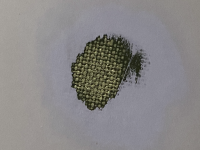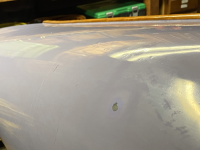My all around favorite is Kirby. Unless you are a builder, I think the amount purchased isn't worth not buying top grades. If well sealed, with minimum air space, they will keep a long time. If we're talking about a canoe like the OP has, they aren't going to be stored outside.
-
Happy Opening of the Maine Turnpike (1947)! 🛣️🦞🌲
You are using an out of date browser. It may not display this or other websites correctly.
You should upgrade or use an alternative browser.
You should upgrade or use an alternative browser.
Touch up painting a wood/Dacron Loon Works
- Thread starter Brightraven
- Start date
- Joined
- Jul 6, 2021
- Messages
- 643
- Reaction score
- 564
I agree with that double negative; it isn’t worth not buying top grades.
Or at least middling grades of intended-purpose marine paints. With the cost delta between a quart of $12 everyday enamel and a quart of Rustoleum Topside at $18, or Kirby (new one to me, thanks) at $21 a quart, the minor expense seems worthwhile.
https://kirbypaint.com/collections/topside-marine-paint
For using leftover quart quantity paint on boats stored outside, even more so.
Although, without a future whole hull or at least bottom scum line use for the leftovers, there are advantages in smaller-than-a-quart quantities
Does anyone sell a decent quality marine or topside paint in pint or half pint cans for touch up work, accent stripes or decorations?
I could have used a pint of black topside. Still could.
Or at least middling grades of intended-purpose marine paints. With the cost delta between a quart of $12 everyday enamel and a quart of Rustoleum Topside at $18, or Kirby (new one to me, thanks) at $21 a quart, the minor expense seems worthwhile.
https://kirbypaint.com/collections/topside-marine-paint
For using leftover quart quantity paint on boats stored outside, even more so.
Although, without a future whole hull or at least bottom scum line use for the leftovers, there are advantages in smaller-than-a-quart quantities
Does anyone sell a decent quality marine or topside paint in pint or half pint cans for touch up work, accent stripes or decorations?
I could have used a pint of black topside. Still could.
- Joined
- Jun 22, 2017
- Messages
- 1,231
- Reaction score
- 1,470
Brightraven, personally I wouldn't try to remove all the current paint and get back to the primer. I might be wrong but it seems like that could be a ton of work and also risk harming the underlying fabric. As someone already mentioned, I'd just scuff the current paint with 220 or 320 grit to give the new paint better grip. But I imagine you'll get all the advice you need from builders like Stewart River. The best forum for advice is the Wooden Canoe Heritage Association (woodencanoe.org).
- Joined
- Jul 6, 2021
- Messages
- 643
- Reaction score
- 564
Dang it, I really could use a pint can of decent quality black marine paint. I use black frequently, but not a lot at a time. I’ve searched, and only marine paints I’ve found come in quarts (or gallons).
Of course I searched for release treated peel ply in rolls for a couple years before Glenn found a source.
Don’t take so long this time Glenn.
Of course I searched for release treated peel ply in rolls for a couple years before Glenn found a source.
Don’t take so long this time Glenn.
I really could use a pint can of decent quality black marine paint.
Of course I searched for release treated peel ply in rolls for a couple years before Glenn found a source.
Don’t take so long this time Glenn.
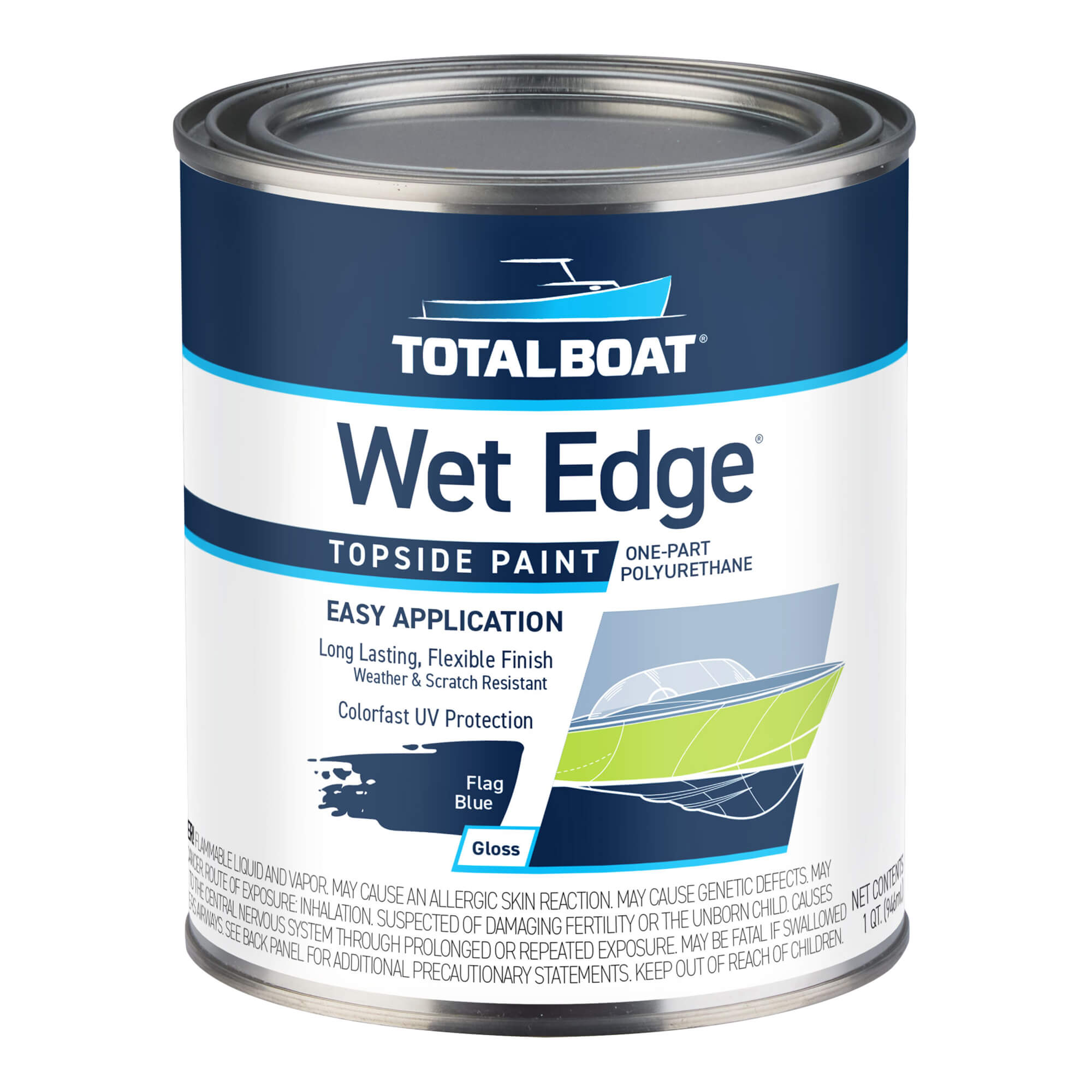
TotalBoat Wet Edge Polyurethane Topside Paint For Boats
One-part polyurethane marine topside paint in 21 popular colors! Can be used on fiberglass, wood, or previously painted surfaces above the waterline.
 www.totalboat.com
www.totalboat.com
- Joined
- Jul 6, 2021
- Messages
- 643
- Reaction score
- 564
Thanks, but that’s $21 a pint! I might as well just order a quart of Rustoleum Topside or Kirby and use the extra somewhere.
Which, for as much black as I use, is probably a good idea. At some point.
I would be hesitant to order a quart unless I had need for at least a pint or more for some project. I was going through the “Small Paints” box today, a dozen half pint cans. Primer Oil, Primer Aluminum, and a lot of (mostly Rustoleum) enamel paint; yellow x2, orange, red x2, orange, blue, black x 2, white. A lot of those half pint cans are ¼ or less full, and bust-the-crust solidifying.
I am bothered by the haz-mat discard responsible of some paints gone bad. Not old latex with kitty litter added, but enamels and epoxies and weird polymers.
Which, for as much black as I use, is probably a good idea. At some point.
I would be hesitant to order a quart unless I had need for at least a pint or more for some project. I was going through the “Small Paints” box today, a dozen half pint cans. Primer Oil, Primer Aluminum, and a lot of (mostly Rustoleum) enamel paint; yellow x2, orange, red x2, orange, blue, black x 2, white. A lot of those half pint cans are ¼ or less full, and bust-the-crust solidifying.
I am bothered by the haz-mat discard responsible of some paints gone bad. Not old latex with kitty litter added, but enamels and epoxies and weird polymers.
Quality marine topside paint is expensive.
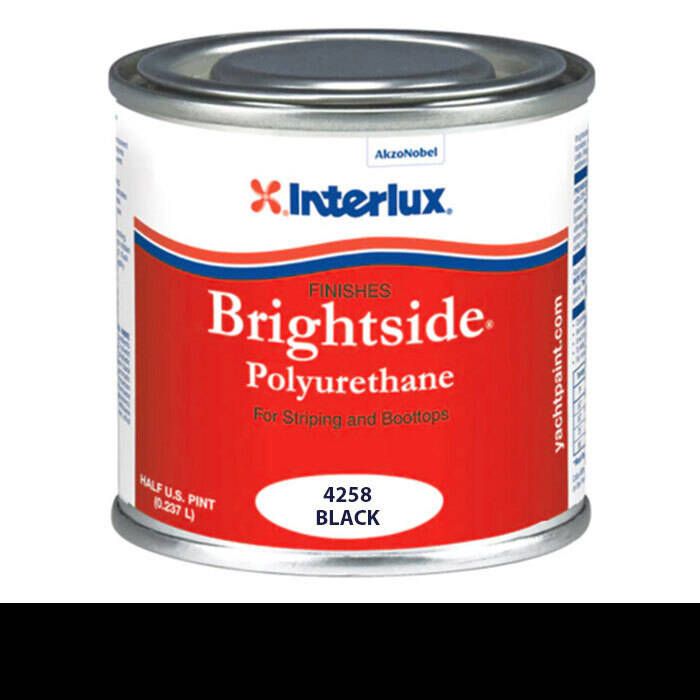
 www.defender.com
www.defender.com

Interlux Brightside Polyurethane
Interlux Brightside Polyurethane is a ready-mixed, one-part linear polyurethane topside finish that offers an enamel's ease of use with the high gloss of a two-part polyurethane. Features: Ideal for boottops and striping High gloss and superb col
I met the former owners daughter last night. Its a shame that the former owner is suffering from demetia. She doesn't know people or where she is.. When Covid hit we did not do our regular dinners out. Now it is too late. The decline was fast but I should have noticed small signs before.I appreciate all these helpful tips and beautiful photos. I’ve included my recent Nakoma here as well...
I’m curious what to do when/if it comes time to repaint the entire hull? Is there a recommended sanding process, respirator choice, and place to do the work...and how deep to sand? Maybe that’s a loaded set of questions but I’m not sure where else to find these answers...
Many thanks!
View attachment 127362
View attachment 127363
Cherish your canoe friends and get out there while you can.
Its a downhill slide starting at class 1 and ending at a waterfall.
I appreciate those touching words, yellowcanoe... Knowing a bit about the lineage of this boat and the people it has held makes the experience all the more reverential...
- Joined
- Jul 6, 2021
- Messages
- 643
- Reaction score
- 564
For small quantity paint a pint or half pint of Wet Edge or Interlux Brightside might be the way to go.
I’ll still wait until I have whole hull painting needed and buy a quart of some topside. Or not, I’d really like a pint of black, maybe with the next order from Jamestown Distributors.
I’ll still wait until I have whole hull painting needed and buy a quart of some topside. Or not, I’d really like a pint of black, maybe with the next order from Jamestown Distributors.
So here is a closeup of the Dacron weave showing...not sure if this is the battleship grey I should be looking for, or if it's gone past that...? Would you just paint right over this? Or should I put something over this before paint?Sand till you see the filler. It should be battleship grey.. Don't sand too deep. That red canoe was sanded till it was faded pink.. Outside with a fan behind me. Actually done at Toms house( Loon Works). I doubt I would have done it well on my own.
That is Jackies former boat She built one with Tom ( not that one) . You can ask her too.
Thanks!
Attachments
Last edited:
The lilac is on the outside and the slate gray is around the weave of the Cecoite that has that waffle pattern. So yes the abrasion goes through the hole. I can't say for cerrtain which dope that is needed ( filler to canoe people dope to air people) Could be Randoproof but I don't know as that type of dope is now green. It used to be blue from what I read on aircraft forums.
Odd to peruse aircraft forii for hints on canoe repair! I would shoot an email to Pam Wedd or Alex Comb
bearwood@vianet.on.ca
Paint Repair [Archive] - EAA Forums
I have 40 year old Ceconite fabric which has been painted over a couple of times according to the log book history (as best I can figure). There are a few areas where the paint is cracking and lifting from the fabric which I would like to repair. I have many questions about the best repair...
eaaforums.org
Odd to peruse aircraft forii for hints on canoe repair! I would shoot an email to Pam Wedd or Alex Comb
bearwood@vianet.on.ca
So I'm waiting to connect with Alex at Stewart River, but did just have a nice brief chat with Pam Wedd. I should have prepared my questions better and was a little confused based on my lack of knowledge and experience in this, but she did mention that she has used 105 epoxy mixed with 410 microlight filler in situations like this, which apparently makes the bonding material less stiff and easier to sand (but I'm wary about what you said about the epoxy, yellowcanoe! I didn't ask if it would penetrate to the planking and create a porcupine!) My understanding is that a thin layer of this could be applied before painting. I asked her if I could just apply paint and she said I could but it would require up to 5-6 coats to thoroughly cover up the weave. Surfacer or glazing compound/putty is another option to build up the surface before applying paint. So, I guess there are options to consider...
I've taken this canoe out in the water twice and there doesn't seem to be a problem, but I am nervous that it could be a problem if this area isn't covered soon. Yellowcanoe, when you mentioned you sanded and then repainted your canoe, I thought that you had brought it down to the Dacron weave (like shown in the photos I attached), and then just applied paint...So I figured I could just apply paint and that it would be a done deal...but if I understand you correctly (which may not be so), is the "filler" worn away in my case, thus warranting the need to add something to prepare the Dacron for the paint to be applied over it?
My apologies if it sounds like I'm beating a dead horse with this question...
I've taken this canoe out in the water twice and there doesn't seem to be a problem, but I am nervous that it could be a problem if this area isn't covered soon. Yellowcanoe, when you mentioned you sanded and then repainted your canoe, I thought that you had brought it down to the Dacron weave (like shown in the photos I attached), and then just applied paint...So I figured I could just apply paint and that it would be a done deal...but if I understand you correctly (which may not be so), is the "filler" worn away in my case, thus warranting the need to add something to prepare the Dacron for the paint to be applied over it?
My apologies if it sounds like I'm beating a dead horse with this question...
nope I brought it down to the dope or filler whichever you want to call it. Remember I was working on refinishing with Tom hovering nearby; so he did not let me go too far. Worked outside in the South Carolina sunny winter.
You have a little spot to fix. In this case the fabric is intact and there is filler inbetween the weaves which ought to stop the epoxy from contacting bare wood. If the cecconite were ripped you would have a different problem ( the porcupine effect with wood)
You have a little spot to fix. In this case the fabric is intact and there is filler inbetween the weaves which ought to stop the epoxy from contacting bare wood. If the cecconite were ripped you would have a different problem ( the porcupine effect with wood)
I have zero experience doing such repairs, but my understanding of the caution against using epoxy on a wood/Dacron canoe is that, when it comes time to replace all the Dacron, it may be very tough to get the old Dacron off if it gets epoxied to the wooden planks.
But you are only fixing one small spot, not saturating an entire hull with epoxy. Even assuming you ever have to replace all the Dacron, I question whether one small epoxied spot would cause more than a trivial removal problem. If Pam Wedd recommends that epoxy/filler combo for a small spot repair, I'd seriously consider it even in my state of relative ignorance.
Putting six coats of paint on the small spot wouldn't be hard either or take much time. The whole idea, I take it, is to protect the Dacron from abrasion and impact damage via some sort of epoxy/filler/paint barrier or a paint/paint/paint/paint/paint/paint barrier.
Alex Comb's email address is alexcomb@gmail.com. You might consider emailing him your two pictures and asking his advice. That's probably easier for him than a phone conversation with no pictures. Might not hurt to say that posters on CanoeTripping.net and WCHA recommended him to you.
But you are only fixing one small spot, not saturating an entire hull with epoxy. Even assuming you ever have to replace all the Dacron, I question whether one small epoxied spot would cause more than a trivial removal problem. If Pam Wedd recommends that epoxy/filler combo for a small spot repair, I'd seriously consider it even in my state of relative ignorance.
Putting six coats of paint on the small spot wouldn't be hard either or take much time. The whole idea, I take it, is to protect the Dacron from abrasion and impact damage via some sort of epoxy/filler/paint barrier or a paint/paint/paint/paint/paint/paint barrier.
Alex Comb's email address is alexcomb@gmail.com. You might consider emailing him your two pictures and asking his advice. That's probably easier for him than a phone conversation with no pictures. Might not hurt to say that posters on CanoeTripping.net and WCHA recommended him to you.
Thanks for all the input...greatly appreciated...
You can see pictures of Alex Comb applying Dacron and filler on a canoe in the following post, which was taken by me from pictures and descriptions on the Stewart River Facebook page. The topic of the entire thread is about how Alex coats the bottoms of many of his wood-Dacron canoes with a mixture of epoxy and graphite. I'm sure he wouldn't do that if it presented a removal problem. Of course, the epoxy/graphite is applied on top of four or five coats of filler, so I doubt the epoxy can saturate down to the wood.
Epoxy w/ Graphite Powder on Bottom of Wood Canoe + How a Wood/Dacron Canoe is Made
Some builders of rib and plank canoes, especially those that use Dacron instead of canvas, paint the bottom below the waterline with a mixture of epoxy and graphite powder instead of the usual marine paint on the rest of the hull. The supposed advantage of this treatment is that the...
www.canoetripping.net
For spot touch ups I sand into the paint but not to the dacron. I've never the entire canoe but I would probably do it the same way.
Some mild battle scarring after a season or two:
 P9280496 by Barry Rains, on Flickr
P9280496 by Barry Rains, on Flickr
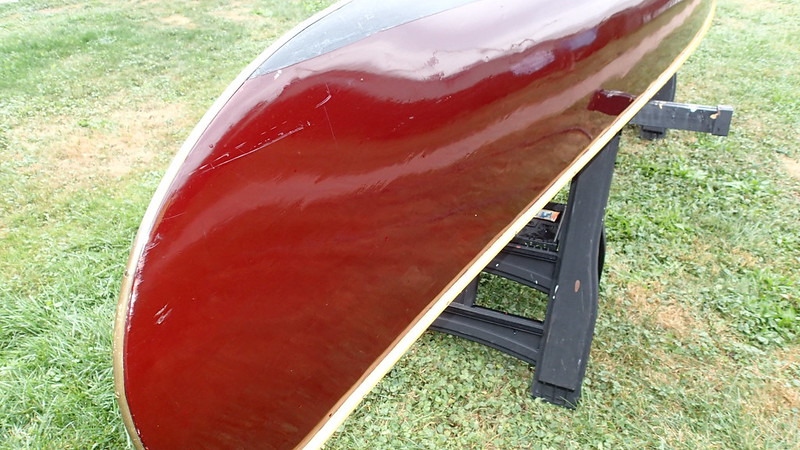 P9280492 by Barry Rains, on Flickr
P9280492 by Barry Rains, on Flickr
Wet Sand 320-400 grit:
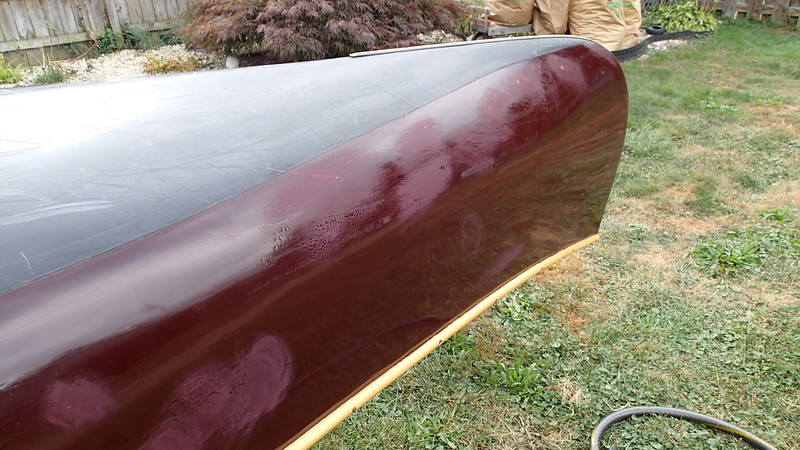 P9280506 by Barry Rains, on Flickr
P9280506 by Barry Rains, on Flickr
 P9280502 by Barry Rains, on Flickr
P9280502 by Barry Rains, on Flickr
 P9280500 by Barry Rains, on Flickr
P9280500 by Barry Rains, on Flickr
 P9280499 by Barry Rains, on Flickr
P9280499 by Barry Rains, on Flickr
Wipe and dry with a clean cloth until it is free of loose paint.
Tape off any areas that I don't want to get paint on in error (here I'll be painting up to the epoxy/graphite finish):
 P9280507 by Barry Rains, on Flickr
P9280507 by Barry Rains, on Flickr
Paint. I used a couple cheap foam brushes and the paint leveled out fine. I don't seem to have a picture of it after I finished.
 P9280510 by Barry Rains, on Flickr
P9280510 by Barry Rains, on Flickr
Cheers,
Barry
Some mild battle scarring after a season or two:
 P9280496 by Barry Rains, on Flickr
P9280496 by Barry Rains, on Flickr P9280492 by Barry Rains, on Flickr
P9280492 by Barry Rains, on FlickrWet Sand 320-400 grit:
 P9280506 by Barry Rains, on Flickr
P9280506 by Barry Rains, on Flickr P9280502 by Barry Rains, on Flickr
P9280502 by Barry Rains, on Flickr P9280500 by Barry Rains, on Flickr
P9280500 by Barry Rains, on Flickr P9280499 by Barry Rains, on Flickr
P9280499 by Barry Rains, on FlickrWipe and dry with a clean cloth until it is free of loose paint.
Tape off any areas that I don't want to get paint on in error (here I'll be painting up to the epoxy/graphite finish):
 P9280507 by Barry Rains, on Flickr
P9280507 by Barry Rains, on FlickrPaint. I used a couple cheap foam brushes and the paint leveled out fine. I don't seem to have a picture of it after I finished.
 P9280510 by Barry Rains, on Flickr
P9280510 by Barry Rains, on FlickrCheers,
Barry
Maybe you could send Alex a new empty quart paint can and ask if he would load it up with the same filler he uses on Dacron fabric and send it to you for a fee if he doesn't sell it on his website?
Barry
Barry
Here comes another idea from the guy with zero experience.
Since Brightraven's gouge does go down to the Dacron, and since there is some concern with applying epoxy or epoxy/filler right on top of the Dacron before painting, how about putting a coat of paint (or primer) on the Dacron first and then applying the epoxy/filler over that first paint barrier? Then put your topcoats of paint over that. Maybe experienced folks could comment on whether this would work to protect the wood from the epoxy.
Waterdog's idea of buying some filler from Alex Comb is a good one, but a quart is far more than needed and is very expensive. From the info on his FB page, THIS is the filler Alex usually uses. Maybe send him a container about 6 ounces in capacity.
Since Brightraven's gouge does go down to the Dacron, and since there is some concern with applying epoxy or epoxy/filler right on top of the Dacron before painting, how about putting a coat of paint (or primer) on the Dacron first and then applying the epoxy/filler over that first paint barrier? Then put your topcoats of paint over that. Maybe experienced folks could comment on whether this would work to protect the wood from the epoxy.
Waterdog's idea of buying some filler from Alex Comb is a good one, but a quart is far more than needed and is very expensive. From the info on his FB page, THIS is the filler Alex usually uses. Maybe send him a container about 6 ounces in capacity.
Similar threads
- Replies
- 9
- Views
- 1K
- Replies
- 7
- Views
- 1K
- Replies
- 14
- Views
- 2K

